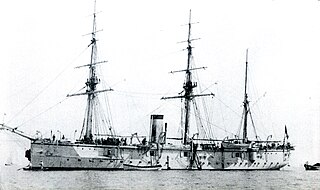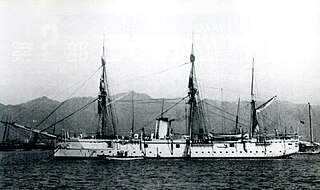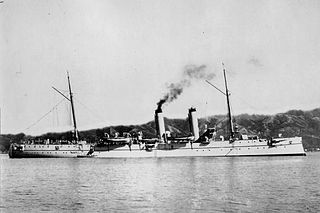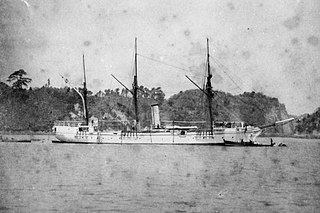
Akagi (赤城) was a steel-hulled, steam gunboat, serving in the early Imperial Japanese Navy. She was the fourth and final vessel to be completed in the four-vessel Maya class and was named after Mount Akagi in Gunma Prefecture.

Akashi (明石) was a Suma-class cruiser protected cruiser of the Imperial Japanese Navy. She was a sister ship to Suma. The name Akashi comes from an ancient name for a portion of the coastline near the modern city of Kobe in Hyōgo Prefecture.

Akitsushima (秋津洲) was a protected cruiser of the Imperial Japanese Navy (IJN), designed and built by the Yokosuka Naval Arsenal in Japan. The name Akitsushima comes from an archaic name for Japan, as used in the ancient chronicle Kojiki.

Sumida (隅田) was a river gunboat in the Imperial Japanese Navy. It was named after the Sumida River in Tokyo, Japan.

Heien, originally known as Pingyuan, built by the Mawei Navy Yard near Foochow (Fuzhou), was an ironclad coastal battleship serving with the Imperial Chinese Beiyang Fleet and later the Imperial Japanese Navy. Previous transliterations of its Chinese name include Ping Yuen and Ping Yuan, also of its Japanese name Heiyen.

Kaimon was a sail-and-steam corvette of the early Imperial Japanese Navy. Although the name Kaimon translates to "sea gate", the ship was named for Mount Kaimon, although written with different kanji, located in Kagoshima prefecture.

Katsuragi (葛城) was the lead ship in the Katsuragi class of three composite hulled, sail-and-steam corvettes of the early Imperial Japanese Navy. The ship was named for a mountain located between Osaka and Nara prefectures.

Yamato was the second vessel in the Katsuragi class of three composite hulled, sail-and-steam corvettes of the early Imperial Japanese Navy. It was named for Yamato province, the old name for Nara prefecture and the historic heartland of Japan. The name was used again for the World War II battleship Yamato, commissioned in 1941.

Musashi (武蔵) was the third and final vessel in the Katsuragi class of composite hulled, sail-and-steam corvettes of the early Imperial Japanese Navy. It was named for Musashi province, a former province of Japan located in the Kantō region. The name was used again for the more famous World War II battleship Musashi.

Miyako (宮古) was an unprotected cruiser of the early Imperial Japanese Navy. The name Miyako comes from the Miyako Islands, one of the three island groups making up current Okinawa prefecture. Miyako was used by the Imperial Japanese Navy primarily as an aviso for scouting, reconnaissance and delivery of high priority messages.

Atago (愛宕) was a composite hulled, steam gunboat, serving in the early Imperial Japanese Navy. She was the third vessel to be completed in the four vessel Maya class, and was named after Mount Atago in Kyoto.

Chōkai (鳥海) was an iron-hulled, steam gunboat, serving in the early Imperial Japanese Navy. She was the second vessel to be completed in the four vessel Maya class, and was named after Mount Chōkai in between Yamagata and Akita Prefectures.

Maya (摩耶) was an iron-hulled, steam gunboat, serving in the early Imperial Japanese Navy. She was the lead vessel in the four vessel Maya class, and was named after Mount Maya in Kobe.

Banjō was a steam gunboat, serving in the early Imperial Japanese Navy. The ship was named after a mountain in Shizuoka prefecture.

Uji (宇治) was an early steam gunboat, serving in the Imperial Japanese Navy. She was named after the city of Uji in Kyoto prefecture. She should not be confused with the later World War II period Hashidate-classUji with the same name

Sumida (隅田) was a river gunboat of the Imperial Japanese Navy, that operated on the Yangtze River in China during the 1940s, and during the Second Sino-Japanese War and World War II.

Fushimi (伏見) was a river gunboat of the Imperial Japanese Navy, that operated on the Yangtze River in China during the 1940s, and during the Second Sino-Japanese War and World War II.

Chihaya (千早) was an unprotected cruiser of the Imperial Japanese Navy. The name Chihaya comes from Chihaya Castle, near Osaka, the site of one of the battles of the Genkō War of 1333.

The Katsuragi class was a three-ship class of composite hulled, sail-and-steam corvettes of the early Imperial Japanese Navy.

The Maya class was a four-ship class of gunboats of the early Imperial Japanese Navy.


















